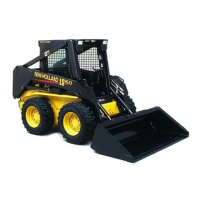SECTION 10 - ENGINE
10-15
LS170 - EXCESSIVE OIL CONSUMPTION
The maximum allowable oil consumption for the
turbocharged diesel engine is 0.8%, as measured
using a log of fuel consumption to oil consumption.
If a customer complains about excessive engine oil
consumption on the Model LS160 or LS170 skid
steer, the following steps must be taken. If a cause is
found, stop and correct the problem. If a cause is not
found, continue to the next step.
1. Examine engine for signs of external oil leaks.
– Check gaskets: oil pan, timing gear case,
head, head cover, injection pump, oil gallery,
and dipstick.
– Oil seals: crankshaft, front and rear.
– Steel tubing and fittings that supply oil to the
turbocharger and upper engine.
– Tubing, hose, and fittings for turbocharger oil
drain to block.
– Damage to oil pan and drain plug.
– Crankcase breather hose (open and not
kinked) preventing proper crankcase
breathing.
2. Examine turbocharger area.
– Remove the hose between the turbocharger
inlet and the air cleaner. Examine for signs of
dirt in the hose and inlet to the turbocharger
blower.
If carbon, oil, and dust are found, check:
– Air cleaner assembly for tightness of filter
elements.
– Hose between air cleaner and turbocharger
for damage or looseness of clamps.
If oil residue is evident on the clean air turbine, it
might not be due to failed turbocharger bearings.
NOTE: A film of oil on the clean air side of the
turbocharger to the intake manifold is normal for skid
steer operation.
Check the air filter and air intake hose for signs
of oil residue.
Check the exhaust area for leaks:
– Exhaust manifold gasket and hardware.
– Turbocharger gasket and hardware, if
equipped.
– Muffler gasket and hardware.
– Muffler failure (cracks, misalignment).
Remove the hose between the turbocharger
outlet and the intake manifold. Check for dirt in
the hose, turbocharger outlet, and the air intake
manifold.
If there is no dirt at the turbocharger inlet but
there is a deposit at the turbocharger blower
outlet (which is not due to signs of dirt in the hose
and inlet to the turbocharger blower), it may be
leakage from the turbocharger seals.
Check turbocharger shaft specifications:
Axial movement: maximum 0.09 mm (0.0035″)
Radial movement: maximum 0.17 mm (0.0067″)
3. Check the blowby hose (valve cover vent hose)
for signs of blockage. If the hose is kinked or the
end is blocked by debris, correct by cutting off the
end of the hose so it is just below the bottom of
the engine oil filter.
4. If there is no problem found in the 1, 2, and 3
checking points, then go to the next step to log oil
consumption.
5. The customer must log oil consumption using the
following procedure:
– Change the engine oil and filter. Use the oil
specified in the loader operator’s manual.
– Run the engine for two minutes.
– Check the dipstick and add oil, if required, so
the level is at the full mark.
– Fill the fuel tank with fuel.
– Record fuel consumption (in gallons), oil
added (in quarts), and hour reading. Record
fuel and oil use for 100 hours of operation,
which is the recommended oil change
interval. Check the dipstick before running
the engine each day.

